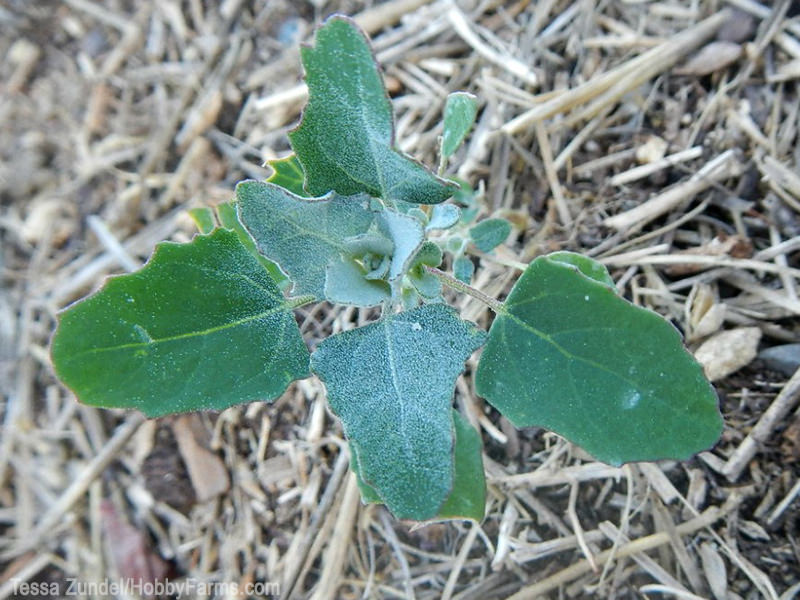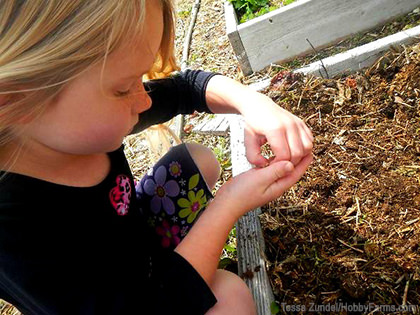

Gardening with children is a lot like cooking with children: a worthwhile investment in the future and an experiment in patience. The secret is to keep it simple, keep it organized and do one thing at a time.
As you teach a garden principle, practice it. For example, after you explain how deep the trench for the asparagus should be, go dig it. Give everyone a job so that they can all contribute to the planting. Even a toddler can dig holes off to the side while you teach older kids to feather out the roots of the asparagus without breaking them.
If you want to grow crops like peas, lettuce and beans, you’ll be working with annual vegetables. Annuals are planted, grown and harvested over the course of one year. Perennials, on the other hand, are only planted once and continue growing for many years after. There’s a place for both in the children’s garden.
An advantage of annuals is that they’re flashy and fast: The rewards are easy to see and you’ll be eating from them in no time. Perennials are more subtle. They’re like a secret that we gardeners tell ourselves every spring. My children have so much fun planting and eating peas (an annual), but discovering the first rhubarb shoots (a perennial) is something they can anticipate every year—it’s like searching for treasure.
If you want to incorporate perennial vegetables into your children’s garden, here are some of my kids’ favorites you can try.
1. Asparagus (Asparagus officinalis)

This is probably everyone’s favorite perennial veggie. The thing our family likes about asparagus is that it comes up out of the ground one at a time, as if someone came along and stuck asparagus spears in the garden. The way asparagus grows makes it simple to instruct children how to harvest. Simply say, “Please go out and cut 20 spears of asparagus right at the ground.” The spears are best picked when they’re short—once they get tall, they get tough. This makes asparagus a good tool for teaching commitment in the garden; you have to check on it every day to make sure nothing goes to waste.
2. Walking Onions (Allium proliferum)

Onions aren’t necessarily a kid’s first vegetable choice, but my children love them because they literally walk across your yard year after year. (And I love them because I can sneak them into my kids’ favorite dishes.) After you plant the onion bulb, it sends up shoots during the year and forms a baby bulb at the top, called a bulblet. The bulb increases in size as it ages and drops to the ground, rooting about 1 foot from the mother plant. Then, it does it all over again, moving forward and to the sides each time. Want to convince your kids that there’s magic in the garden? Introduce them to walking onions.
3. Scarlet Runner Beans (Phaseolus coccineus)

While scarlet runner beans are technically a tender perennial, in some zones they act more like an annual, dying back in the winter and re-growing in the spring from seeds dropped to the ground. These beans are beautiful! The seeds are purple or pinkish with black spots, and the flowers are bright red. There are several varieties of runner beans and they all vary a bit in flower and seed color.
The vines are strong and vigorous, so they’re perfect for growing up playhouse walls or tepee trellises. They’ll cover a small structure in a season, providing hours of shaded enjoyment in the children’s garden. The beans are completely edible picked fresh, but are really yummy dried. They put one in mind of a certain boy name Jack and his magical beanstalk.
4. Jerusalem Artichoke (Helianthus tuberosus)

Jerusalem artichokes (aka sunchokes) are a tuber, similar to an iris tuber. The tops will die back every winter but will pop right back up in late spring. Be careful with these because the tubers proliferate easily and abundantly. This can be a great thing for an edible garden because you can, indeed, eat them.
They taste like a cross between a potato and an artichoke when cooked, which is probably how they got their name, as they’re in no way related to artichokes. When raw, they taste a lot like a water chestnut. The tubers can be knobby, which gets annoying when you’re trying to clean them and prepare them for eating; try the Fuseau variety for fewer knobs.
Jerusalem artichokes produce 5- to 7-foot stalks with small, sunflower-type flowers and provide a great privacy screen for any low-lying fort or fairy house. Once the stalks have died back, they make excellent play swords for backyard imaginings and great kindling for the fire.
5. Lamb’s Quarters (Chenopodium album)

This is also known as Fat Hen, which indicates you can use it to feed your poultry. While lamb’s quarters is actually a reseeding annual, believe me, it’s not afraid of winter and will be back in spring. This weed is one of the very first things to start popping up in the garden, and we love it. It reseeds very easily and prolifically, so some people battle with it, but I know several wild foragers who deliberately planted the seed in their yard so they can harvest it.
The baby shoots are wonderful in salad or added to stir-fry. My kids think it’s groovy when we cook the weeds from the garden. Once the leaves of lamb’s quarter get a bit bigger, we use them in place of spinach, which needs a bit more time in our climate to be safe from the frosts. In fact, it tastes a lot like spinach, only better—kind of nutty and full of spring.
So, there you have it! Did I neglect one of your favorite perennials? Set me straight in the comments below.
Visit my blog if you want some ideas on annual vegetables and fruits for a children’s garden.
« More Farm Sprouts »




